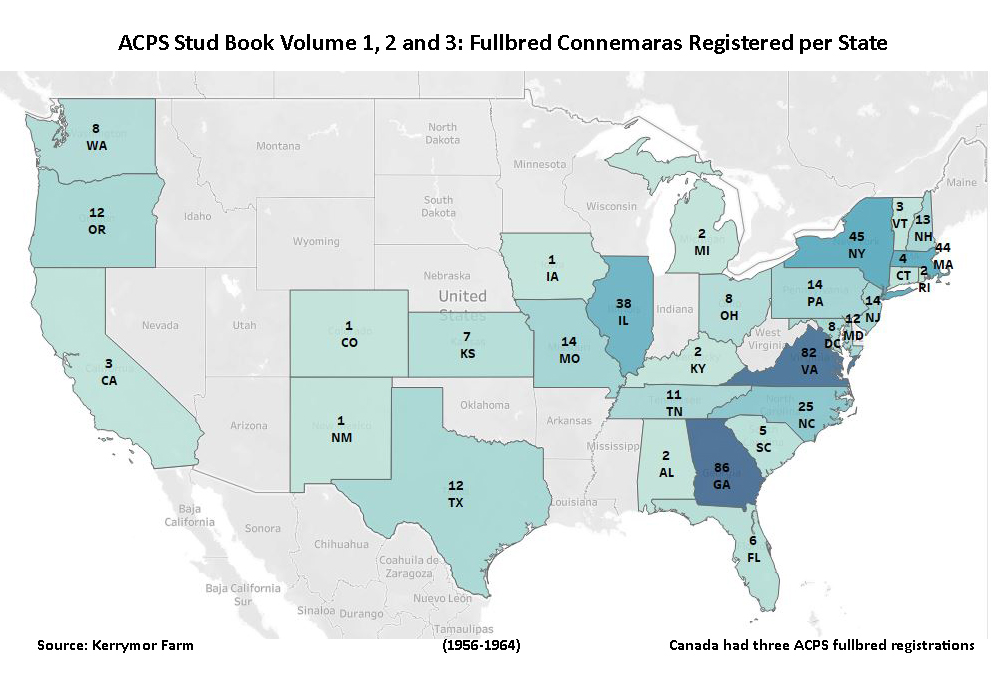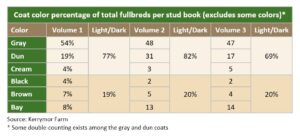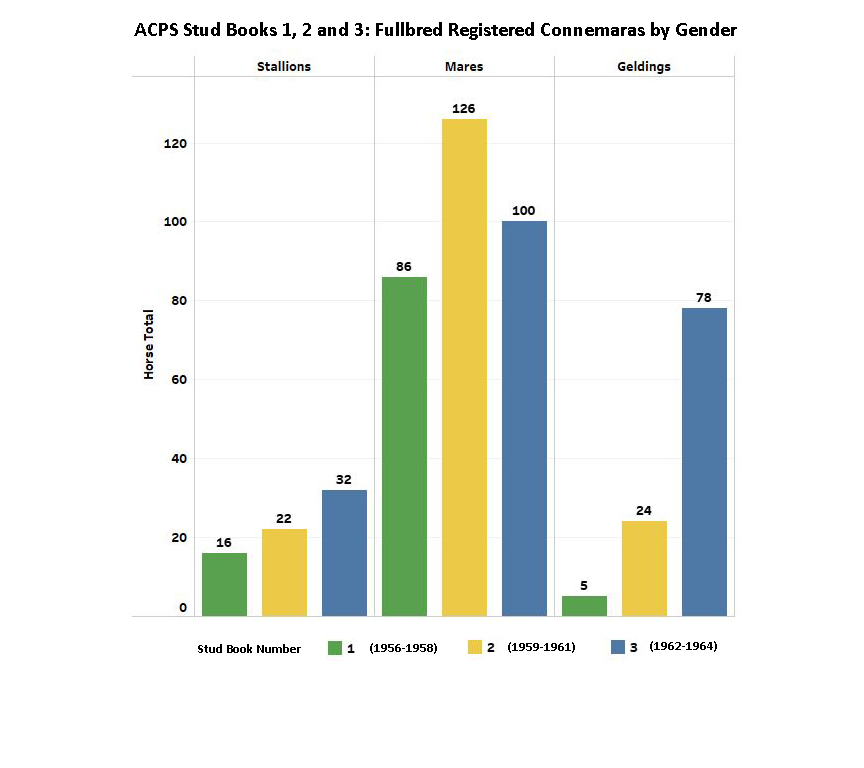ACPS Stud Book Volume 3: Fullbred Registrations Increase to 489 for First Three Volumes

Volume 3 of the “American Connemara Pony Stud Book” covered registrations for the years of 1962 to 1964 and was published in 1965.
By this time, the American Connemara Pony Society was seeing registrations for fullbred Connemaras across 29 states, the District of Columbia and Canada, up from 20 states and DC in Volume 2.
Total registered fullbred Connemaras (excluding temporary foal certificates) in the US had increased to 489 for the first three volumes—up from 271 in Volumes 1 and 2.
Date Issue
Permanent registrations in the stud books had no dates. However, temporary foal certificates included a note of the permanent registration date for Connemaras that were fully registered before the three-year volume was published.
Ideally, every entry in the stud books would have included a date because it might have solved this problem:
Some temporary foal certificate listings in Volume 3 included permanent registration dates of 1965, indicating this volume included some 1965 data. However, Volume 4 had permanent registration dates in the TFCs ranging from 1965 to 1968, overlapping Volume 3, so we’re not using those dates as an indicator of the intended date range for the volume overall.
We believe Volume 3 was intended to record permanent registrations for three years, 1962 to 1964. If we find out otherwise, we will make adjustments to this post.
ACPS officials
Alvin Mavis, of Mavis Farms, was president when Volume 3 was printed.
The three vice presidents were Dr. Walter H. Fordham Jr., Douglas W. Chatterley and Joseph Sisto.
Mrs. Bruce Read (Charlotte) of Round Robin Farm remained secretary and treasurer after holding that title in Volume 2.
Mrs. Carl C. Johnson again was assistant secretary.
Mrs. Magruder Dent Jr. (Rosemary Romeyn Dent) of Polaris Farm in Charlottesville, Virginia, again was publicity chairman and added the title of show chairman.
And Mrs. William J. Clough was membership chairman.
The board now consisted of 15 members, up from 13 in Volume 2.
ACPS membership
Read included one secretary’s report, dated 1965, for the three-year volume.
She noted that a membership drive in 1965 resulted in a total of 21 life members, 37 annual senior members, 17 annual joint members (husband and wife) and 36 junior members. The society had increased to 111 members from 40 in Volume 2.
Membership fees
The membership fees had increased, as well.
Juniors 18 and under were $1 per year.
Seniors were $10 per year.
Husband and wife joint memberships were $15 per year.
And life memberships were $100.
In Volume 1, the fees had been $1 for juniors, $3 for seniors and $20 for life members.
Connemara performance
The standard Page 3 introduction of the Connemara and its history provided an update on Dundrum, halfbred son of Thoroughbred Little Heaven, saying, “He will have his name among the immortals of the horse world someday.”
Dundrum’s accolades included Queen Elizabeth presenting the George V Cup to the gelding in 1963 at the Royal International Horse Show at White City, London, and Dundrum bringing great victory to Ireland in 1963 with the winning of the Aga Khan Trophy at the Royal Dublin Show.
The introduction also listed other Connemaras making a name in the open show world in the United States.
Whitewood Muffin, American-bred champion hunter pony many times over, had been shown successfully at the big Harrisburg, Washington International and Madison Square Garden shows.
And An Tostal, American-bred winner of one- and three-day events, had an intermediate division rating with the United States Combined Training Association. His registration data indicated that he was 13.3 and 1/2 hands.
Volume 3 Registrations
Volume 3 registered 210 fullbred Connemaras, made up of 32 stallions, 100 mares and 78 geldings.
There were 319 fullbred temporary foal certificates, a sizable leap from 222 in Volume 2. Volume 3 temporary foal certificates consisted of 140 stallions, 163 mares and 16 geldings.
The halfbred section contained permanent registrations for 16 mares and three geldings. There were 33 temporary foal certificates for halfbreds, made up of 10 stallions, 22 mares, and one gelding.
Cancellations
Volume 3 included entries for canceled registrations, a first in the stud books.
Sir William’s Coco (by MacDara out of Heathstone) initially was registered as a halfbred mare, with No. 12, but the registration was canceled and re-issued for fullbred mare USAM 286.
She was 13 hands. Maybe height played a role at some point.
Seven temporary foal certificates, consisting of five fullbreds and two halfbreds, were canceled outright. Most information was withheld, so perhaps publishing the cancellations merely accounted for the TFC numbers.
Top breeders
Robert H. Wright Jr. of Rose Hill (or often Rosehill) Farm registered the most fullbred horses (as he did in Volume 2), with 12 total, consisting of four stallions, three mares and five geldings.
Wright also registered 39 temporary foal certificates, made up of 21 stallions, 17 mares and one gelding. Twenty-eight were not also registered fully in the three-year volume. Thus, Wright registered a total of 40 Connemaras in Volume 3, below the 69 that he registered in Volume 2 but still a big number (see the end of this post for biological info on Wright).
Other leaders in previous stud books registered fewer Connemaras in Volume 3, as well. Rosemary Dent (Mrs. Magruder Dent Jr. of Polaris Farm) registered five fullbreds, while Mavis Farms registered three.
Magalen O. Bryant (formerly Crane) registered seven fullbreds under her new Madcap Farm name (see the “Other interesting trivia” section below for additional info). She also registered 12 temporary foal certificates under Madcap Farm, with no duplication with the permanent entries.
William Dolph, who led fullbred registrations in Volume 1 with 22, registered no Connemaras. He sold 10 — his stellar stallions *Texas Hope and *Texas Pride and eight mares. In Volume 2, he had sold three mares. He sold *Texas Hope to James Bailey, of Lynfields Farm in Lyndonville, Vermont. After we visited Lynfields Farm in 1975, my parents remarked how Jim positively beamed when he was showing us his stallion. No one has ever seemed more proud. Dolph sold *Texas Pride to John Huffine and Barbara Bennett of Manakin, Virginia.
New height rule
Volume 3 introduced a new height rule under the “Points of the Connemara” section, with no explanation beyond the rule. The society had created a Section 1 for Connemaras 13 to 14.2 hands and a Section 2 for those over 14.2 hands.
“Section 2” wording was added to Connemaras’ registration among the regular listings. There was no special section in the volume for the taller Connemaras.
Three fullbred Connemaras had Section 2 designations: stallion Round Robin’s Tam O’Shanter (by An Tostal out of Sandy Grey), at 14.3 hands; mare Round Robin’s Sandstorm (again, by An Tostal out of Sandy Grey), at 14.3 hands; and gelding Whitewood Easter (by Tully N***** out of Winter Mollie), at 15.2 hands.
The designation was applied to two halfbred mares but not a halfbred gelding.
Shortness issues re-emerged
Being too short had re-emerged as something the ACPS considered a problem and hindered the registration of two mares.
Fullbred Sir William’s Starlight (by Camus John out of Sir William’s Coco), a 12-2 hand mare, was registered as a halfbred with a note that the offspring would be eligible for the fullbred division if they met the height requirement.
And fullbred Madcap Irish Candy (by Whitewood Galway Bay out of Madcap Taffy), an 11-3 hand mare, also was registered as a halfbred with no note at all.
General height numbers
Somewhat confusingly, five other fullbreds (four mares and a gelding) were under 13 hands, all of them 12-3 hands or a little over 12-3, with no notes signaling there were issues with their height.
Eighty-one fullbreds were 14 hands or taller, representing 39 percent of the 210 registered fullbreds. This compared with 13 fullbreds that were 14 hands or taller in Volume 1, representing 12 percent of the 107 fullbreds in that volume.
In Volume 3, the remaining 124 fullbreds were in the 13 hand range.
Color trends
As for coat color in Volume 3 fullbreds, 98 were gray, 35 dun, three gray dun (counted in both groups), five black, 29 bay, nine brown, 10 cream, eight palomino, with one described as cream or palomino (counted in both groups), six chestnut, and 28 roans. The roans consisted of eight gray roans (counted in both groups), five bay roans (counted in both groups), two black roans (counted in both groups), a blue roan, a light red roan, four strawberry roans plus a gray strawberry roan (also counted in the grays), a dark roan and five roans.
Double-counting creates a problem for making comparisons. We’re working on a solution. Right now, the double-counting remains.
Gray Connemaras accounted for 54 percent of fullbreds in Volume 1, 48 percent in Volume 2 and 47 percent in Volume 3, while duns represented 19 percent in Volume 1, 31 percent in Volume 2 and 17 percent in Volume 3.
What’s interesting to us is black, brown and bay fullbred Connemaras combined accounted for 19 percent of fullbreds in Volume 1 and 20 percent in Volumes 2 and 3, a far higher percentage than certain factions within the society would admit as they have pressed for a more similarly colored breed. And there’s no double-counting in those numbers (meaning no one registered variations such as black brown or black bay). Black, brown and bay coats were added and compared with total fullbred registered ponies. The variety in coat color has always existed.

Transfers
There were 94 transfers of permanently registered Connemaras, made up of 15 fullbred stallions, 71 fullbred mares, two fullbred geldings and six halfbred mares. We don’t see any transfer listings for temporary foal certificates.
M. G. Britt of Fairfax, Virginia, transferred the most Connemaras — nine — to his or her name, while Mr. Ted Britt, also of Fairfax and presumably of the same family, transferred one. Norbert Fritz of Fredericksburg, Texas, ranked second, transferring six to his name. The Baileys of Lynfields Farm ranked third, transferring five to their name.
Other interesting trivia
Secretary Read mentioned that ACPS membership included a quarterly newsletter, which apparently had begun publishing and likely was the reason that the secretary’s report was becoming briefer in each stud book volume.
There were some unusual entries and mistakes in this volume that had not been seen earlier.
Volume 3 had a page out of order, showing ACPS stallion registration USAS 104 (for gelding Round Robin’s Rally), 105 (for gelding Inisbofin Chipmunk) and 106 (for gelding Patrick O’Toole) six pages later than expected. All ACPS numbers were accounted for in the end.
An asterisk was missing from the registration for imported mare Aura Dun, ACPS USAM 143, and permanently registered in Ireland, though 10 other Connemaras with a permanent CPBS number in the volume carried the asterisk. It likely was a typo.
There were temporary foal certificates two numbers apart for a mare of nearly the same name, with a possessive S moving from the farm name to the mare’s name between entries, but the foals had different listed birth dates and were born more than a year apart. Perhaps the first foal died and the name was reused. Perhaps it was a mistake.
The Harris family’s Hideaway Stables became Hideaway Farm in Volume 3, though not consistently.
The Harris family registered several horses under a business name of Genavon, but it sometimes was listed as Genovan. Genavon is correct.
Also, the Harris family registered a temporary foal certificate (No. 543) for Erin Go Bragh in 1965.
The Hideaway’s Erin Go-Bragh (USAS 448) the horse world has come to know and love was born in 1983 so it wasn’t the same Connemara.
Horses carrying the RBR farm name hailed from Wainer’s River Bottom Ranch in Valdosta, Georgia. That’s not an easy one to track down.
And Magalen O. Crane changed her horses’ farm name from Whitewood to Madcap, likely mirroring a change in her life, as she divorced her first husband, William Crane Jr., and, in 1964, married J.C. Herbert Bryant. Newspaper clippings covering her death in July 2021 said Magalen and her new husband were prominent figures in Thoroughbred horse racing and steeplechasing. It did not mention her involvement in Connemaras.
Who was Robert H. Wright Jr.?
I have found background information on Robert Hardaway Wright Jr. It doesn’t explain why he went all in on Connemaras, but it does explain how he could afford it.
Wright received a news obituary in The Columbus Ledger of Georgia on Dec. 27, 1973, after he died at age 73. His wife died the previous year.
The Ledger said Wright was president of Wright Contracting Co., one of the major contracting firms in the US. The company, along with other construction firms, handled projects in several countries, including Saudi Arabia, Pakistan, Portugal and Spain.
Wright took an active part in the management of the building of the $130 million Oraville Dam in California’s Feather River in the mid-1960s.
The Ledger said Wright’s Connemara herd at one time numbered more than 100, the largest in the US. He donated much of the herd to various groups, including the Alto School for Boys in Rome, Georgia, and the Georgia Baptist home at Hapeville, Georgia, plus several universities.
He and his wife also traveled extensively due the business.
He was a native of Tuscaloosa, Alabama, and had a son and daughter.
—–
Read our summaries of other ACPS Stud Book Volumes
—–
Below are Volume 3 images of Connemara mares from Lynfields Farm and Connemaras An Tostal, Ballyconneely Fergus, Georgia’s Mister Irish, Laxfield Gil Tully, and Tooreen Laddie.






